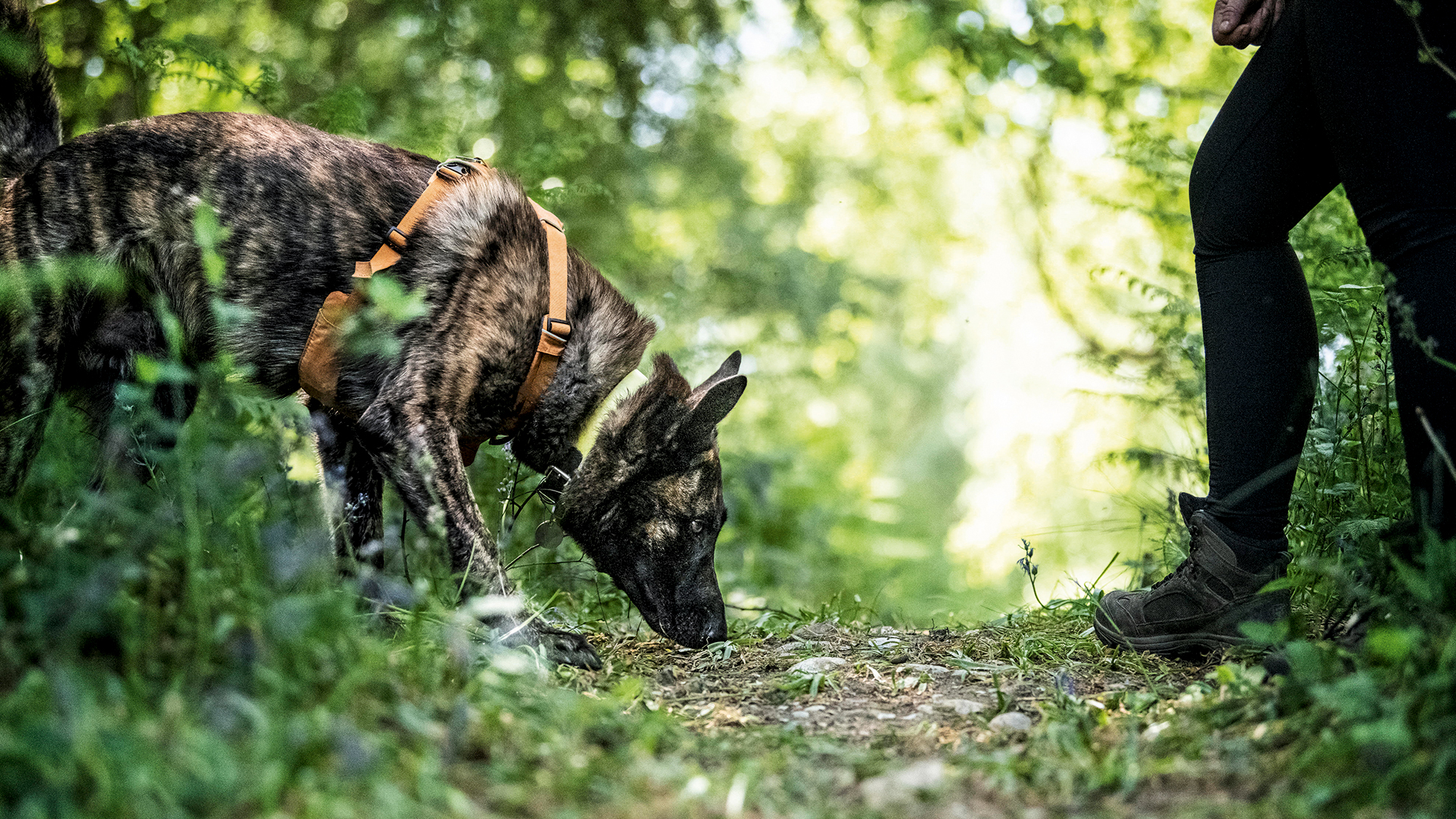How sniffer dogs have moved on from drugs and bombs to Japanese knotweed
Kat Janczur spent years training dogs to sniff out drugs and explosives. Today, she and her canine companions have a very different quarry: Japanese knotweed.

Trotting through the woods, Fenix could be any other dog out enjoying the late-autumn sunshine. But, as we turn into a large scrubby patch of land, Kat Janczur takes out a khaki harness and Fenix’s demeanour changes: the apparel signifies that work is about to begin. Kat gives the Dutch shepherd his instructions; after only a few minutes, he sits expectantly at a small bushy plant.
We follow, eager to see the discovery. Kat delves into her pocket for a biscuit, which Fenix happily gulps before he is dispatched to the next area of the site. His quarry is Japanese knotweed, an invasive non-native species that can become problematic if not appropriately managed and, under the 1990 Environmental Protection Act, must be removed by and disposed of by specialists.
These include Knotweed Services UK, which works in partnership with Kat and her dogs at Canine Detection Solutions to help ensure no plant is missed — a challenge with this particular species, as it can lie dormant under the surface. Kat has trained her team — Fenix and spaniels Nettle and Nica, named after Fallopia japonica, the scientific name for knotweed — to identify soil containing knotweed roots (known as rhizomes).
‘If a plant is hidden, the dogs tend to lie down rather than sit,’ points out Kat. ‘It’s especially useful in gardens where we don’t want any unnecessary digging.’ It’s also invaluable on construction sites, where Fenix has been able to save thousands of pounds in disruption by detecting residual knotweed.
Described by the RHS as a ‘fast-growing and strong clump-forming perennial with tall, dense annual stems’, Japanese knotweed was imported from Central Asia as an ornamental plant during the 19th century.
As have many other non-native invasive species, knotweed has become ubiquitous in the UK — at considerable cost to native flora. However, unlike other species, there are legal requirements to manage its spread — any growth onto a neighbouring property could result in fines. Mortgage lenders generally insist that any knotweed identified in surveys is eradicated before property purchases are made. ‘Homeowners don’t necessarily want knotweed to be found,’says Kat. ‘Sometimes, it has been concealed under concrete slabs — but there’s no hiding from Fenix!’
Sniffing out knotweed is a relatively new practice and Kat has been working with Dr Daniel Jones of invasive-plants consultancy Advanced Invasives to assess its reliability; further peer-reviewed research is expected imminently. Anyone who has undertaken field work with a dog will be aware of their extraordinary sense of smell — certainly, Kat is never in doubt of their abilities, having spent many years in the Netherlands training dogs to sniff out narcotics and explosives.
Exquisite houses, the beauty of Nature, and how to get the most from your life, straight to your inbox.
To ensure that Kat’s behaviour doesn’t unintentionally bias Fenix’s identification, Clive Brooker, director at Knotweed Services, has organised an informal test as part of today’s demonstration, held on a site close to the organisation’s headquarters just outside Birmingham. It takes a smidge longer for the dog to make his decision about the next section. He settles near a leggy buddleia, where a knotweed plant, hidden from human view, lies dormant.
‘That’s a plant that has already had herbicide treatment,’ notes Mr Brooker. For the final task, Fenix is sent into a previously cordoned-off area. He wanders around for a few minutes. After a while, Mr Brooker comes clean: there’s no knotweed there. Fenix is given biscuits and his favourite ball, and the khaki harness is removed.
It’s an impressive display — and one that has been several years in the making. ‘There are a lot of steps in the training,’ explains Kat. ‘I start at the beginning of winter, when there isn’t a lot of knotweed, and then, as the year progresses, the scent changes — the dogs need to experience the life cycle of the plant.
‘As with any sniffer training, you need a dog that is motivated by work. I teach them that the scent of the knotweed is associated with their favourite toy.’
Although Fenix isn’t bothered about bramble bushes, he does wear shoes when on construction sites. ‘He’s happy working alongside humans,’ says Kat, adding: ‘The dogs can do this job with-out me, but I can’t do it without them.’

Credit: Alamy Stock Photo
Japanese knotweed: How a delicate bloom beloved of the Victorians became a modern British scourge
Japanese knotweed took Britain by storm in the 19th century as a beautiful and highly-prized plant that was hugely fashionable.

How letting invasive plants jump the garden fence could land you in court
Charles Quest-Ritson looks at invasive plants and what to watch out (or look for) in our gardens.

Invasive aliens: Six of the most destructive plants and animals that have made Britain their home
Hundreds of species that we take for granted are actually non-native species. Dan Eatherley, author of Invasive Aliens: The Plants